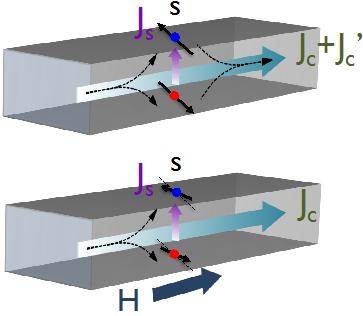A new magnetoresistance effect occurring in materials with strong spin-orbit coupling

Top: Schematic of the direct spin Hall effect (and its inverse) in a thin film of a material with strong spin-orbit coupling. Bottom: schematic of the Hanle magnetoresistance effect when an external magnetic field is applied. Credit: PR
The ultimate goal of spintronics is to have a deeper understanding of the charge-to-spin conversion and transport phenomena at the nanoscale in order to be able to design new functional and efficient devices that are not only based on the injection, transport and storage of electrical charge, but also to its spin, which could revolutionize the conventional electronics and expand its limits.
The researchers show that, by means of this novel magnetoresistive effect, it is now possible to study the spin transport properties in these materials without the need to fabricate complex devices and/or involve interfaces between different materials.
When an electric current is applied to a thin film of a material with strong spin-orbit coupling (typically of a few nanometers thick), a spin current is generated in the transverse direction -that is, along the thickness of the film- via the direct spin Hall effect, which in turn produces an electric current (via the inverse spin Hall effect) that adds to the initial applied current.
This effect -small since it is due to a second-order correction-, causes a reduction in the resistivity of the film, and is maximum when the film thickness is on the order of to the spin diffusion length -that is, the average distance that a spin can travel through the material without suffering a collision that may cause a change in its state.
If a magnetic field is applied not collinear to the direction where the spins points to, one can force them to precess -via the so-called Hanle effect-, thereby generating a modulation in the resistivity of the material. According to Saul Velez, first author of the work, “this new phenomenon could open ahead the possibility to study the spin transport in materials and systems not yet explored”.
“This new effect also allows to study the spin transport properties of known materials, and to compare the results with the ones obtained with other techniques or devices”, adds Fèlix Casanova, last author and supervisor of the work.
Media Contact
Irati Kortabitarte
i.kortabitarte@elhuyar.com
34-943-363-040
Media Contact
All latest news from the category: Materials Sciences
Materials management deals with the research, development, manufacturing and processing of raw and industrial materials. Key aspects here are biological and medical issues, which play an increasingly important role in this field.
innovations-report offers in-depth articles related to the development and application of materials and the structure and properties of new materials.
Newest articles

Superradiant atoms could push the boundaries of how precisely time can be measured
Superradiant atoms can help us measure time more precisely than ever. In a new study, researchers from the University of Copenhagen present a new method for measuring the time interval,…

Ion thermoelectric conversion devices for near room temperature
The electrode sheet of the thermoelectric device consists of ionic hydrogel, which is sandwiched between the electrodes to form, and the Prussian blue on the electrode undergoes a redox reaction…

Zap Energy achieves 37-million-degree temperatures in a compact device
New publication reports record electron temperatures for a small-scale, sheared-flow-stabilized Z-pinch fusion device. In the nine decades since humans first produced fusion reactions, only a few fusion technologies have demonstrated…





















